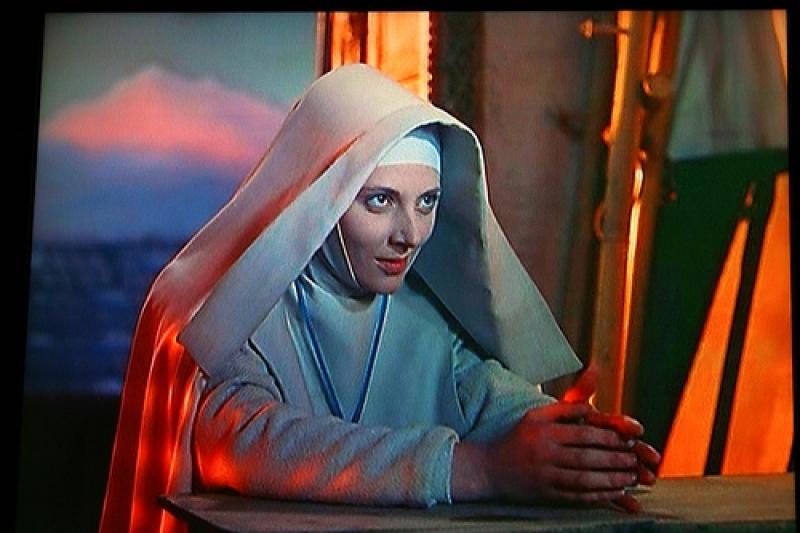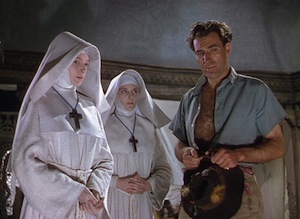DVD Release: Black Narcissus | reviews, news & interviews
DVD Release: Black Narcissus
DVD Release: Black Narcissus
The Powell and Pressburger classic gets the scholarly treatment

Violet may be the most violent colour in the spectrum, but its emotional equivalent in the cinema of Michael Powell is red, which frequently symbolises overwhelming sexual and artistic desire. Powell fetishised redness - and redheads like Deborah Kerr and Moira Shearer.
In The Red Shoes, the scarlet ballet slippers worn by Shearer’s Vicky Page gleam, and her Titian mane - “the most glorious…I had ever seen on a woman”, Powell wrote, “and I’ve seen some” - is backlit into a burnt-orange cloud that contrasts with the fire-engine red of her lips and eventually her spilled blood. In Black Narcissus, adapted from Rumer Godden’s novel about five Anglo-Catholic nuns losing their bearings in their windswept Himalayan convent, the Archers depict a battle of wills between the demure Sister Superior, Clodagh (Deborah Kerr), and her sick alter ego, Sister Ruth (Kathleen Byron), who erotomaniacally cathects the virile British agent, Mr Dean (David Farrar).
Clodagh’s hair, when seen in flashblacks to her pre-monastic existence among the Irish hunting-and-fishing set, is a burnished auburn; Ruth - minus wimple - has no shaved head, but a coppery tangle that turns Medusa-ish when dampened by sweat. When Ruth boasts to Clodagh of staunching a patient’s blood in the convent’s hospital, the splashes of gore on her habit mimic the bright powder red of Dean’s shirt. The bejewelled silks of the Old General (Esmond Knight) who lends the Mopu palace to the nuns are postbox-red. The uninhibitedly carnal Indian teenager Kanchi (Jean Simmons), slyly dumped on the nuns by Dean, sports huge red beads and a tan, blue and green dress dominated by red (though her cowl is an ironic Madonna-blue). One of the concubines painted on the walls of the convent, formerly a brothel, wears a pinkish-red shift.
The Archers offer no reassurance to women negotiating the red mists of desire
And there’s the notorious lipstick scene, of course. Going out of her wits and renouncing her vows, Ruth dons a dark crimson dress and anoints her mouth tomato red - ripe for biting - as she prepares to announce her love for Dean. It’s not her he’s fallen for, however, but her adversary, and in the moment he acknowledges this to himself, he is seen in the bloody wash of Ruth’s subjective viewpoint as she faints with the shock of it. There follows the great expressionistic sequence - the composed film-within-the film, influenced by Snow White and the Seven Dwarfs, that’s set to Brian Easdale’s chilling operatic score and anticipates the Red Shoes ballet. It incorporates an immense closeup of Ruth’s red-rimmed eyes and culminates with her emerging like a Gothic wraith, her lurid crimsons transformed into deathly blacks, from the red hell of a doorway to attack Clodagh as she tolls the dawn Angelus above a yawning precipice.
 Reds are contrasted throughout the film with blues and greens, the colour clashes redolent of the psychic disturbance experienced by the nuns in their mountain eyrie. Initially sceptical of Clodagh’s hubristic attempt to establish a Christian-imperial island state in a pagan world, Dean becomes her confidante. “There’s something in the atmosphere that makes everything seem exaggerated,” he says - not least the cloistered women’s repressed libidos. The Archers relate sexuality to narcissism. In the Irish flashbacks, Clodagh’s eyes light up when she receives gifts of jewellery, and she admires herself in front of a mirror wearing a string of emeralds, as Kanchi admires herself in mirrors. Whereas the young Indian primitive luxuriates in her sex appeal, however - she seduces the feckless Young General (Sabu), whose “peacock” attire and favaoring of Black Narcissus perfume renders him effeminate - Clodagh’s decision to become a nun after her Irish boyfriend deserted her seems regressive.
Reds are contrasted throughout the film with blues and greens, the colour clashes redolent of the psychic disturbance experienced by the nuns in their mountain eyrie. Initially sceptical of Clodagh’s hubristic attempt to establish a Christian-imperial island state in a pagan world, Dean becomes her confidante. “There’s something in the atmosphere that makes everything seem exaggerated,” he says - not least the cloistered women’s repressed libidos. The Archers relate sexuality to narcissism. In the Irish flashbacks, Clodagh’s eyes light up when she receives gifts of jewellery, and she admires herself in front of a mirror wearing a string of emeralds, as Kanchi admires herself in mirrors. Whereas the young Indian primitive luxuriates in her sex appeal, however - she seduces the feckless Young General (Sabu), whose “peacock” attire and favaoring of Black Narcissus perfume renders him effeminate - Clodagh’s decision to become a nun after her Irish boyfriend deserted her seems regressive.
If Ruth’s liberated libido becomes the weapon of her emancipation, it also precipitates her destruction. It’s been argued that Clodagh throws off her repression to bring about her relocation as a women who must struggle again in the world, far from Mopu, but liberation is denied her, as it is to Vicky in The Red Shoes and the sensual but childish Hazel (Jennifer Jones) in Gone to Earth (1950). Restoring patriarchal values, the Archers offer no reassurance to women negotiating the red mists of desire. Indeed, the yearnings of Ruth, Vicky, and Hazel are all silenced by their death plunges.
 The Black Narcissus DVD is a beauty, featuring a spectacular high-definition digital transfer sourced from the same master used for the British video release in 2008 and created with the participation of the late Jack Cardiff, the film's cinematographer, and Thelma Schoonmaker Powell, the director’s widow. It was Cardiff’s triumph as much as the Archers' and his Oscar-winning work is celebrated in the 27-minute documentary Painting With Light (Craig McCall’s forerunner to his 2010 feature Cameraman: The Life and Work of Jack Cardiff). Among the interviewees are Cardiff - wonderful explaining the three-strip Technicolor process and the influence of Vermeer, Rembrandt, and Van Gogh - and Byron, who recounts how she wisely prevailed over Powell in deciding how Ruth should behave (with subdued erotic delight rather than hysteria) when she explores Dean’s empty bungalow. This anecdote and other details also crop up in a conventional British TV featurette. The French director and critic Bertrand Tavernier, an early champion of the Archers, contributes a stirring introduction and an insightful interview offering historical perspective. The audio commentary by Powell and Martin Scorsese, recorded in 1988, is pleasing, but you might just want to let the iridescent images and the music flow as Powell and his collaborators intended.
The Black Narcissus DVD is a beauty, featuring a spectacular high-definition digital transfer sourced from the same master used for the British video release in 2008 and created with the participation of the late Jack Cardiff, the film's cinematographer, and Thelma Schoonmaker Powell, the director’s widow. It was Cardiff’s triumph as much as the Archers' and his Oscar-winning work is celebrated in the 27-minute documentary Painting With Light (Craig McCall’s forerunner to his 2010 feature Cameraman: The Life and Work of Jack Cardiff). Among the interviewees are Cardiff - wonderful explaining the three-strip Technicolor process and the influence of Vermeer, Rembrandt, and Van Gogh - and Byron, who recounts how she wisely prevailed over Powell in deciding how Ruth should behave (with subdued erotic delight rather than hysteria) when she explores Dean’s empty bungalow. This anecdote and other details also crop up in a conventional British TV featurette. The French director and critic Bertrand Tavernier, an early champion of the Archers, contributes a stirring introduction and an insightful interview offering historical perspective. The audio commentary by Powell and Martin Scorsese, recorded in 1988, is pleasing, but you might just want to let the iridescent images and the music flow as Powell and his collaborators intended.
The future of Arts Journalism
You can stop theartsdesk.com closing!
We urgently need financing to survive. Our fundraising drive has thus far raised £49,000 but we need to reach £100,000 or we will be forced to close. Please contribute here: https://gofund.me/c3f6033d
And if you can forward this information to anyone who might assist, we’d be grateful.

Subscribe to theartsdesk.com
Thank you for continuing to read our work on theartsdesk.com. For unlimited access to every article in its entirety, including our archive of more than 15,000 pieces, we're asking for £5 per month or £40 per year. We feel it's a very good deal, and hope you do too.
To take a subscription now simply click here.
And if you're looking for that extra gift for a friend or family member, why not treat them to a theartsdesk.com gift subscription?
more Film
 London Film Festival - from paranoia in Brazil and Iran, to light relief in New York and Tuscany
'Jay Kelly' disappoints, 'It Was Just an Accident' doesn't
London Film Festival - from paranoia in Brazil and Iran, to light relief in New York and Tuscany
'Jay Kelly' disappoints, 'It Was Just an Accident' doesn't
 Iron Ladies review - working-class heroines of the Miners' Strike
Documentary salutes the staunch women who fought Thatcher's pit closures
Iron Ladies review - working-class heroines of the Miners' Strike
Documentary salutes the staunch women who fought Thatcher's pit closures
 Blu-ray: The Man in the White Suit
Ealing Studios' prescient black comedy, as sharp as ever
Blu-ray: The Man in the White Suit
Ealing Studios' prescient black comedy, as sharp as ever
 The Woman in Cabin 10 review - Scandi noir meets Agatha Christie on a superyacht
Reason goes overboard on a seagoing mystery thriller
The Woman in Cabin 10 review - Scandi noir meets Agatha Christie on a superyacht
Reason goes overboard on a seagoing mystery thriller
 London Film Festival 2025 - crime, punishment, pop stars and shrinks
Daniel Craig investigates, Jodie Foster speaks French and Colin Farrell has a gambling habit
London Film Festival 2025 - crime, punishment, pop stars and shrinks
Daniel Craig investigates, Jodie Foster speaks French and Colin Farrell has a gambling habit
 I Swear review - taking stock of Tourette's
A sharp and moving tale of cuss-words and tics
I Swear review - taking stock of Tourette's
A sharp and moving tale of cuss-words and tics
 A House of Dynamite review - the final countdown
Kathryn Bigelow's cautionary tale sets the nuclear clock ticking again
A House of Dynamite review - the final countdown
Kathryn Bigelow's cautionary tale sets the nuclear clock ticking again
 theartsdesk Q&A: Idris Elba on playing a US President faced with a missile crisis in 'A House of Dynamite'
The star talks about Presidential decision-making when millions of lives are imperilled
theartsdesk Q&A: Idris Elba on playing a US President faced with a missile crisis in 'A House of Dynamite'
The star talks about Presidential decision-making when millions of lives are imperilled
 Urchin review - superb homeless drama
Frank Dillane gives a star-making turn in Harris Dickinson’s impressive directorial debut
Urchin review - superb homeless drama
Frank Dillane gives a star-making turn in Harris Dickinson’s impressive directorial debut
 Mr Blake at Your Service review - John Malkovich in unlikely role as an English butler
Weird comedy directed by novelist Gilles Legardinier
Mr Blake at Your Service review - John Malkovich in unlikely role as an English butler
Weird comedy directed by novelist Gilles Legardinier
 Don't Let's Go to the Dogs Tonight review - vivid adaptation of a memoir about a Rhodesian childhood
Embeth Davidtz delivers an impressive directing debut and an exceptional child star
Don't Let's Go to the Dogs Tonight review - vivid adaptation of a memoir about a Rhodesian childhood
Embeth Davidtz delivers an impressive directing debut and an exceptional child star

Add comment